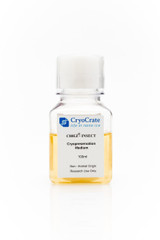BACKGROUND
M. Austin, a researcher at the Danforth Plant Sciences Center in St. Louis, had been subculturing Sf9 cells for over 10 years without stopping. "We needed our Sf9 cells to be available", said Austin. "We were afraid to stop, even when there is a gap in experiments, because Sf9 cells are expensive to order and take time to get growing properly, if they ever do." After conferring with researchers at CryoCrate, Austin's team decided to investigate the utility of C80EZ-INSECT to improve their protocol.
EXPERIMENT
In the experiment, Austin tested reconstituted cells frozen for one month at -80C in C80EZ-INSECT media vs. cells that had never been frozen. After thawing, cells were cultured in a monolayer for three months as were cells from their standard suspension cultures. Cells from each group were infected with four viruses that work on endogenous cells to produce a steroid alkaloid called verazine. The amount of verazine produced would be correlated to the amount of protein produced.
RESULTS
Austin reported, "My results show that the difference between fresh and frozen cells is insignificant. In fact, the cells that were frozen in C80EZ-INSECT produced more verazine than our normal protocol. These variations can be explained by numerous factors, including the initial cell count. The overarching point is that cells frozen and reconstituted performed well. We will probably stop splitting ours and just depend on the frozen ones since these results were so good."

